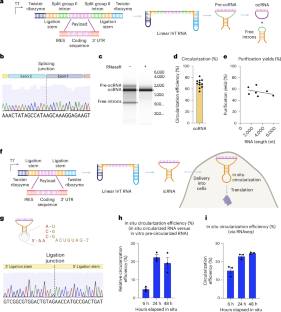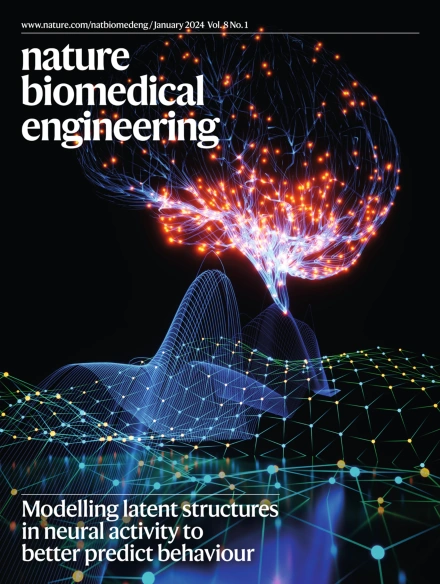通过体外和原位环化 RNA 实现强大的基因组和细胞工程。
IF 26.8
1区 医学
Q1 ENGINEERING, BIOMEDICAL
引用次数: 0
摘要
环化可以提高 RNA 的持久性,但目前还缺乏简单且可扩展的方法来实现这一目标。在这里,我们报告了两种有助于实现环状 RNA(cRNA)的方法:利用第二组内含子通过体外环化开发的 cRNA,以及利用普遍表达的 RtcB 蛋白通过细胞内环化开发的 cRNA。我们还报告了一些简单的纯化方案,这些方案在保持低免疫反应的同时,还能获得较高的 cRNA 产量(40-75%)。这些方法和方案有助于干细胞工程的广泛应用,以及通过锌指蛋白和CRISPR-Cas9进行强大的基因组和表观基因组靶向。值得注意的是,与心肌细胞和神经元中的线性封顶 RNA 相比,带有脑心肌炎内部核糖体入口的 cRNA 能在心肌细胞和神经元中实现稳健表达和持久性,这凸显了 cRNA 在这些非分裂细胞中的实用性。我们还介绍了通过以 cRNA 形式递送的去免疫化 Cas9 进行基因组靶向,以及用于组合筛选去免疫化蛋白质变体的长程多重蛋白质工程方法,该方法可使 cRNA 递送蛋白质的表达持久性和免疫原性兼容。cRNA 工具集将有助于研究和开发治疗药物。本文章由计算机程序翻译,如有差异,请以英文原文为准。


Robust genome and cell engineering via in vitro and in situ circularized RNAs
Circularization can improve RNA persistence, yet simple and scalable approaches to achieve this are lacking. Here we report two methods that facilitate the pursuit of circular RNAs (cRNAs): cRNAs developed via in vitro circularization using group II introns, and cRNAs developed via in-cell circularization by the ubiquitously expressed RtcB protein. We also report simple purification protocols that enable high cRNA yields (40–75%) while maintaining low immune responses. These methods and protocols facilitate a broad range of applications in stem cell engineering as well as robust genome and epigenome targeting via zinc finger proteins and CRISPR–Cas9. Notably, cRNAs bearing the encephalomyocarditis internal ribosome entry enabled robust expression and persistence compared with linear capped RNAs in cardiomyocytes and neurons, which highlights the utility of cRNAs in these non-dividing cells. We also describe genome targeting via deimmunized Cas9 delivered as cRNA and a long-range multiplexed protein engineering methodology for the combinatorial screening of deimmunized protein variants that enables compatibility between persistence of expression and immunogenicity in cRNA-delivered proteins. The cRNA toolset will aid research and the development of therapeutics. Two simple and efficient methods for RNA circularization and a complementary Cas9 deimmunization method enhance a broad range of applications in genome and cell engineering.
求助全文
通过发布文献求助,成功后即可免费获取论文全文。
去求助
来源期刊

Nature Biomedical Engineering
Medicine-Medicine (miscellaneous)
CiteScore
45.30
自引率
1.10%
发文量
138
期刊介绍:
Nature Biomedical Engineering is an online-only monthly journal that was launched in January 2017. It aims to publish original research, reviews, and commentary focusing on applied biomedicine and health technology. The journal targets a diverse audience, including life scientists who are involved in developing experimental or computational systems and methods to enhance our understanding of human physiology. It also covers biomedical researchers and engineers who are engaged in designing or optimizing therapies, assays, devices, or procedures for diagnosing or treating diseases. Additionally, clinicians, who make use of research outputs to evaluate patient health or administer therapy in various clinical settings and healthcare contexts, are also part of the target audience.
 求助内容:
求助内容: 应助结果提醒方式:
应助结果提醒方式:


